[ad_1]


In Brief
2024 was a turbulent year for the NFT market, with significant swings in trading volumes and sales, marking one of the worst NFT performance years since 2020.

With notable swings in trading volumes and sales counts, 2024 was one of the most turbulent years for the NFT market, according to DappRadar. Although the year started off positively, the market had difficulties as the months went by, which led to one of the worst NFT performance years since 2020. Overall, NFT performance mirrored the wider volatility of the digital asset field despite some encouraging advances and growing use in specific industries.
Early Optimism: A Good Start for 2024
With trade volumes soaring in the first quarter, the year got off to a positive start. Compared to the same time in 2023, the NFT trading volume increased by 4% to almost $5.3 billion in Q1. A number of things contributed to this early momentum, including the rising demand for digital collectibles and the expanding application of blockchain technology in a variety of sectors. After declines in prior years, NFTs appeared to be poised for a robust resurgence in the first few months of 2024.
The Mid-Year Downturn: Q2 and Q3 Difficulties
As the year went on, the optimism soon faded. NFT trading volumes fell precipitously to barely $1.5 billion by the third quarter of 2024. The market had lost a lot of its initial impetus, as seen by this steep decline in volume. This downturn was caused by a number of causes, including shifting investor mood, regulatory uncertainty, and broader economic pressures.
While trading volume remained low during Q3, there was a slight rebound in Q4, with volumes rising to $2.6 billion. Yet, this recovery was not enough to offset the significant losses seen earlier in the year. The general trend for 2024 pointed to a market in decline, with trading activity failing to maintain the highs of previous years.
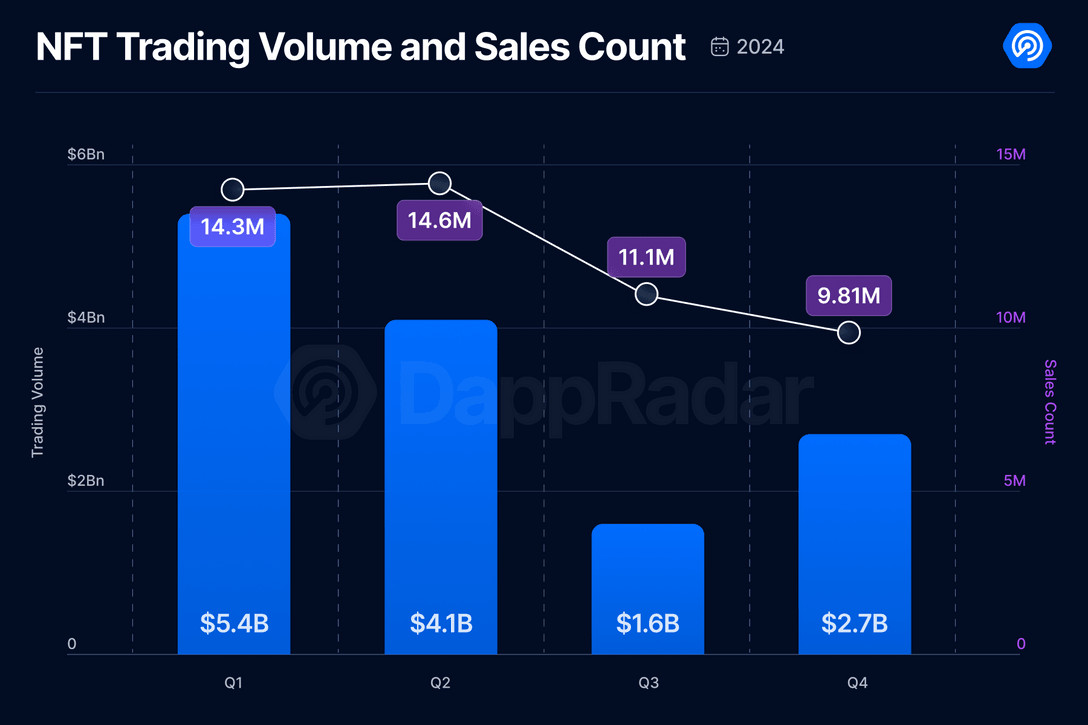
Photo: DappRadar
NFT Collections: Shifting Dominance and New Collaborations
In 2024, there were notable shifts in the top NFT collections. The Pudgy Penguins’ performance was among the most noteworthy instances. Despite being one of the best collections in terms of trading volume, Pudgy Penguins had a 44% decline in sales over the prior year. In spite of this drop, Pudgy Penguins’ floor price increased by 114%, indicating a tendency toward fewer, higher-value transactions.
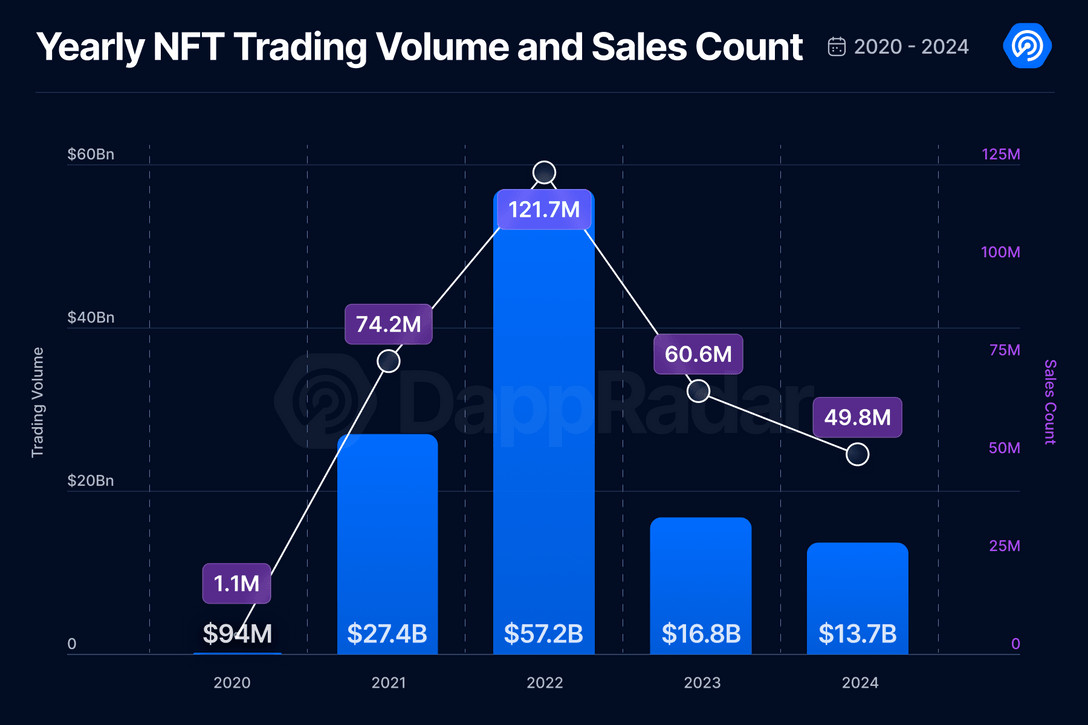
Photo: DappRadar
Pudgy Penguins’ 2024 success may be ascribed to their calculated attempts to diversify outside of the internet sphere. The collection helped boost real-world prominence by introducing plush toys to well-known stores, including Walmart, Walgreens, Target, Selfridges, and Argos in the United Kingdom.
In May 2024, Pudgy Penguins and Mythical Games also collaborated to create a smartphone game that uses blockchain. The goal of this partnership was to include their well-known penguin characters in a top-notch gaming experience, supporting the expanding trend of NFTs with practical applications. When Pudgy Penguins partnered with Spanish football side CD Castellón in September 2024, they became the first profile picture (PFP) NFT collection to appear on a professional football team’s kit.
On the other hand, Yuga Labs, which has historically controlled the NFT market, experienced a drop in floor pricing and trading volumes in 2024. Although its general dominance was diminished, Yuga Labs was still one of the most traded collections despite these difficulties.
With plans for its immersive metaverse platform, Otherside, and a possible new project in partnership with PP Man scheduled to premiere in 2025, the company’s dedication to innovation has not wavered. Yuga Labs is not giving up on its market position, as seen by its attempts to broaden its product offerings and investigate new prospects in the metaverse.
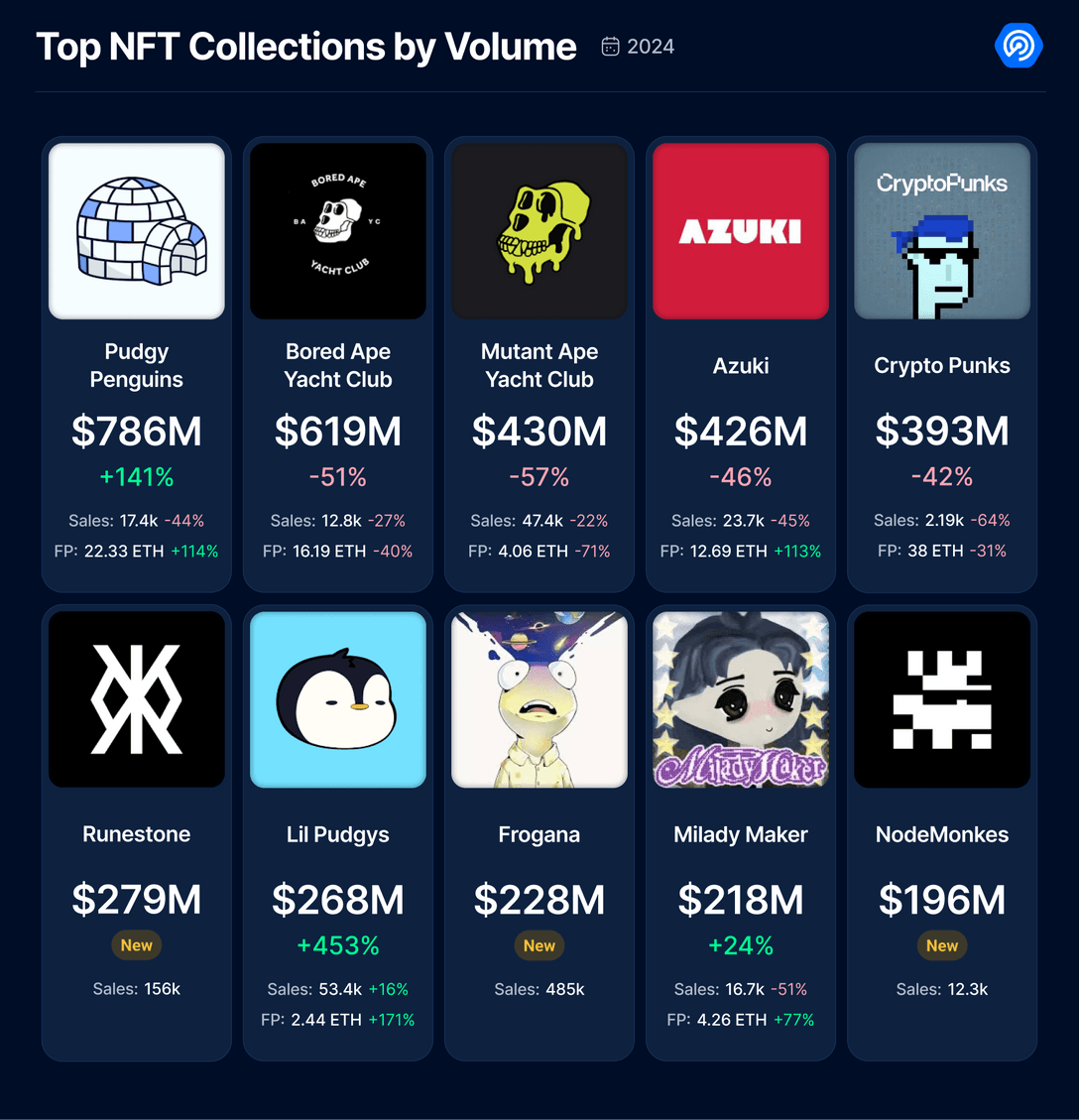
Photo: DappRadar
The Gaming Industry: Fueling NFTs’ Future
In 2024, the gaming industry was one that saw steady expansion. Since these digital collectibles gave players the opportunity to really own their in-game goods and take part in player-driven economies, NFTs connected to gaming and in-game assets were gaining popularity. NFTs with useful, in-game functions were in high demand, as seen by the dominance of gaming-related NFTs in sales figures. This pattern was indicative of a more general change in the market, as NFTs were becoming valued assets in virtual worlds and gaming platforms as well as collectors.
In the upcoming years, it is anticipated that the gaming industry’s use of NFTs would further increase. Blockchain technology’s use into gaming opens up new possibilities for both gamers and developers, improving the player experience and generating new revenue streams. NFTs in gaming will probably grow in importance as this trend develops, and further advancements are anticipated to influence the direction of digital assets in the future.
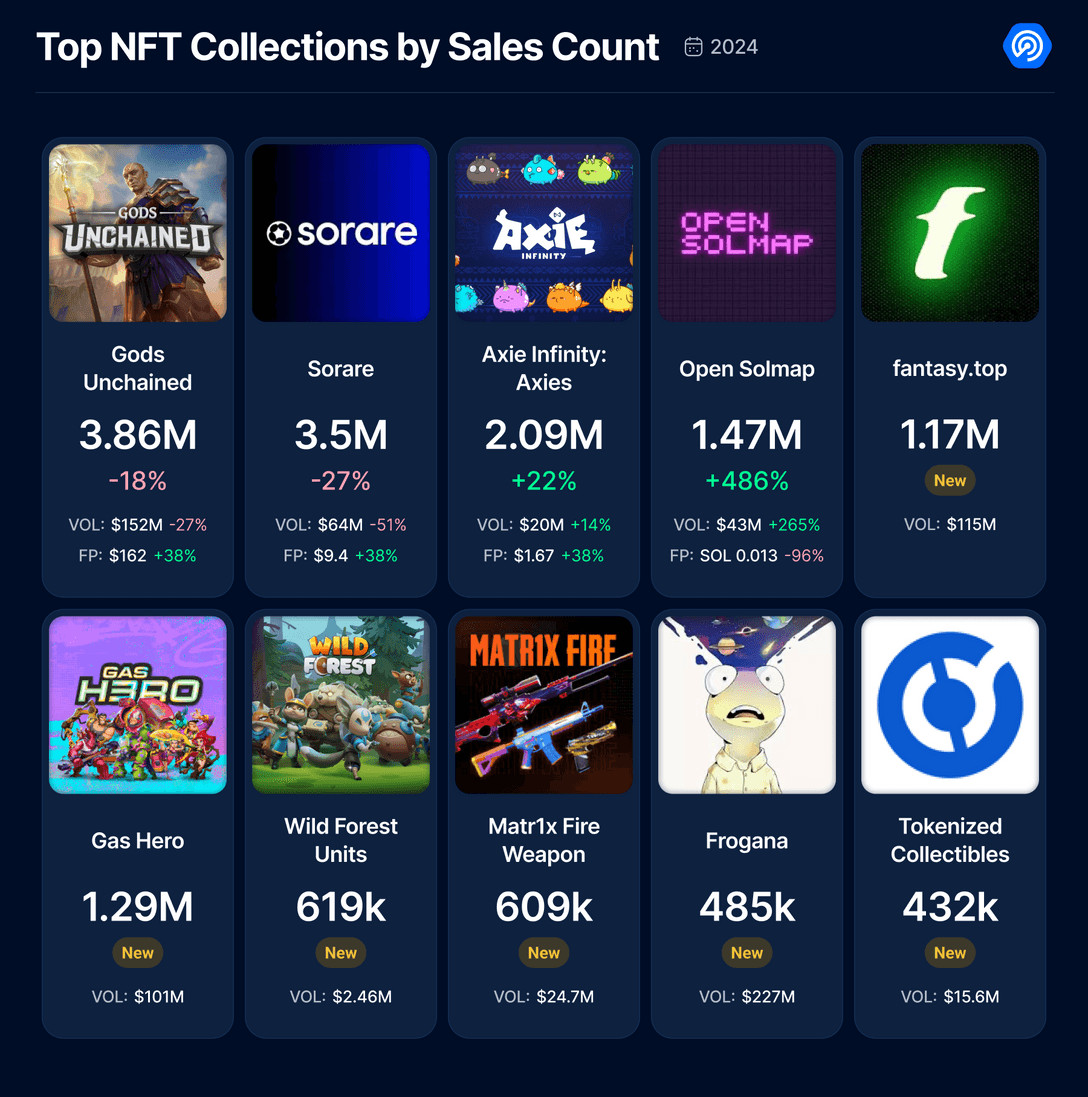
Photo: DappRadar
OpenSea vs. Blur, The Conflict of Marketplaces
Blur established its supremacy in NFT markets in 2024, holding the top spot for most of the year. Blur’s zero-fee trading strategy, which drew traders trying to cut expenses, was a major factor in its success. Additionally, the company started a number of airdrop efforts to expand its user base and awareness.
Yet, it was a difficult year for OpenSea, the established leader in the NFT business. The U.S. Securities and Exchange Commission (SEC) sent OpenSea a Wells Notice in August 2024 for unregistered securities. A weakening market, intense competition, and regulatory pressure caused OpenSea to announce large layoffs in November, cutting its personnel by 56%. In an attempt to recover market share, OpenSea declared intentions to relaunch with a new platform version, called “OpenSea 2.0,” despite these obstacles. Additionally, the platform is hinting at the possible release of a coin that would open up new doors for its ecosystem’s producers and collectors.
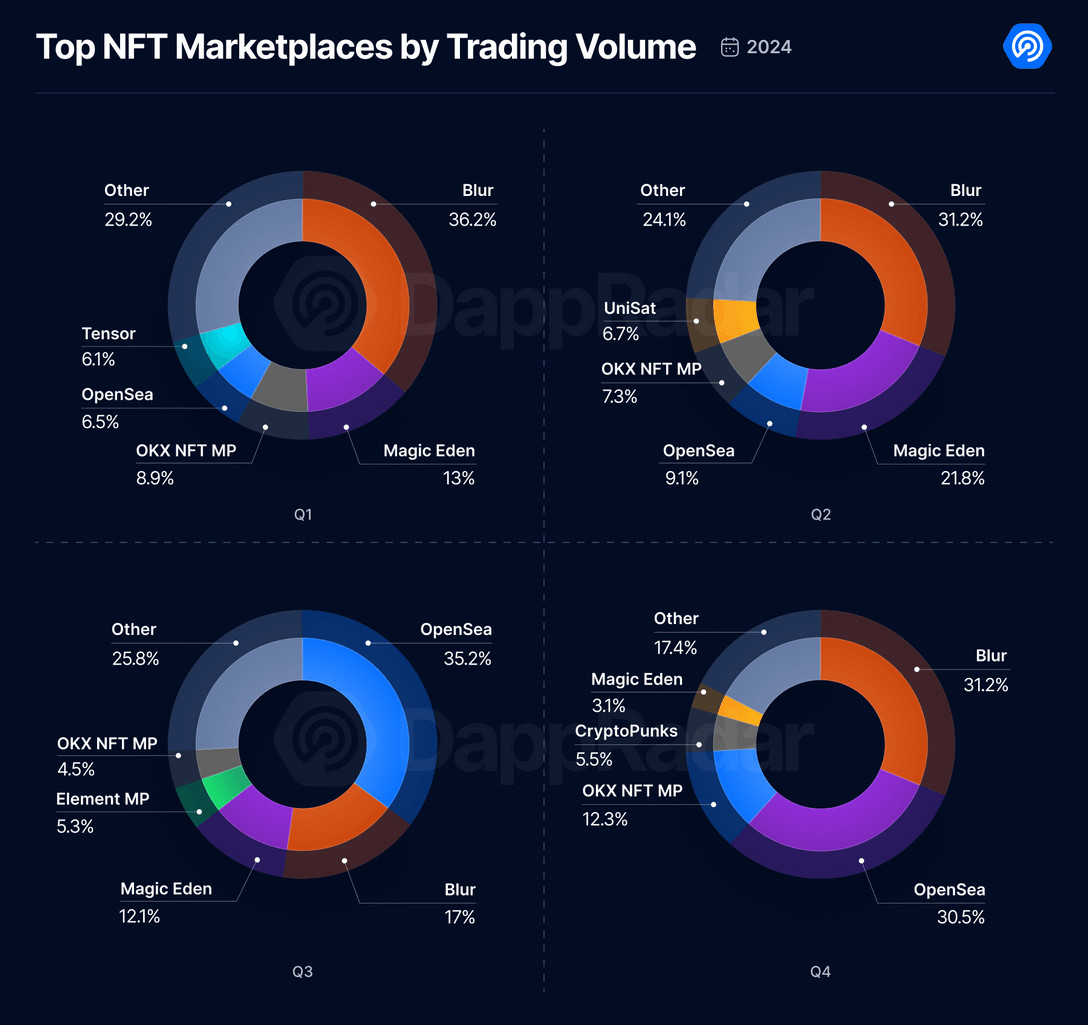
Photo: DappRadar
In 2024, however, Magic Eden—a platform that first concentrated on Solana—performed better than OpenSea. In addition to Bitcoin, Ethereum, and Polygon, Magic Eden also offers more recent networks like Base and Arbitrum. In order to fortify its ecosystem, Magic Eden introduced its native ME coin in December 2024, along with a $700 million airdrop. With this growth and calculated decision to broaden its product line, Magic Eden established itself as a major force in the market competition and may have changed the balance of power in the NFT sector.
In 2024, the NFT ecosystem kept developing beyond individual collections and marketplaces. The diversification of NFT use cases was one of the major developments. NFTs discovered new uses in industries including gaming, music, real estate, and ticketing, even if digital art and collectibles continued to be a primary emphasis. The growing use of NFTs in various industries showed that they may provide practical benefits outside of the digital sphere.
Disclaimer
In line with the Trust Project guidelines, please note that the information provided on this page is not intended to be and should not be interpreted as legal, tax, investment, financial, or any other form of advice. It is important to only invest what you can afford to lose and to seek independent financial advice if you have any doubts. For further information, we suggest referring to the terms and conditions as well as the help and support pages provided by the issuer or advertiser. MetaversePost is committed to accurate, unbiased reporting, but market conditions are subject to change without notice.
About The Author
Victoria is a writer on a variety of technology topics including Web3.0, AI and cryptocurrencies. Her extensive experience allows her to write insightful articles for the wider audience.

Victoria d’Este

Victoria is a writer on a variety of technology topics including Web3.0, AI and cryptocurrencies. Her extensive experience allows her to write insightful articles for the wider audience.
[ad_2]
Read More: mpost.io










 Bitcoin
Bitcoin  Ethereum
Ethereum  Tether
Tether  XRP
XRP  Solana
Solana  USDC
USDC  TRON
TRON  Dogecoin
Dogecoin  Lido Staked Ether
Lido Staked Ether  Cardano
Cardano  Wrapped Bitcoin
Wrapped Bitcoin  Hyperliquid
Hyperliquid  Wrapped stETH
Wrapped stETH  Bitcoin Cash
Bitcoin Cash  Sui
Sui  LEO Token
LEO Token  Chainlink
Chainlink  Stellar
Stellar  Avalanche
Avalanche  USDS
USDS  Toncoin
Toncoin  WhiteBIT Coin
WhiteBIT Coin  Shiba Inu
Shiba Inu  Binance Bridged USDT (BNB Smart Chain)
Binance Bridged USDT (BNB Smart Chain)  Litecoin
Litecoin  WETH
WETH  Wrapped eETH
Wrapped eETH  Hedera
Hedera  Ethena USDe
Ethena USDe  Monero
Monero  Polkadot
Polkadot  Bitget Token
Bitget Token  Coinbase Wrapped BTC
Coinbase Wrapped BTC  Pepe
Pepe  Uniswap
Uniswap  Pi Network
Pi Network  Dai
Dai  Aave
Aave  Ethena Staked USDe
Ethena Staked USDe  OKB
OKB  BlackRock USD Institutional Digital Liquidity Fund
BlackRock USD Institutional Digital Liquidity Fund  Bittensor
Bittensor  Aptos
Aptos  sUSDS
sUSDS  Cronos
Cronos  Internet Computer
Internet Computer  Jito Staked SOL
Jito Staked SOL  NEAR Protocol
NEAR Protocol  Ethereum Classic
Ethereum Classic